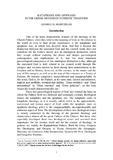| dc.description.abstract | One of the main characteristic features of the theology of the Church Fathers, when they refer to the meaning of God, to His relation to the world or even to their divine experiences, is the kataphatic and apophatic way, in which they describe them. And that is because the distinction between the uncreated God and the created world does not constitute for the Fathers merely just an ontological distinction, which they accept without realizing the direct and deeper gnoseological consequences and implications of it. And the most imminent gnoseological consequence of this ontological distinction is that, although the uncreated God is truly related to the created world through His energies and becomes known by them during their manifestation in the Creation and in History, however, in His essence, in the nature and the way of His energies, as well as in the way of His existence as a Trinity of Persons, He remains completely transcendental and unapproachable. In this sense, God is, for the Fathers, at the same time, known and unknown, explicit and ineffable, revealed and hidden, “Deus revelatus” and “Deus absconditus” or “Deus secretus” and “Deus publicus”, as the holy Augustine would characteristically say. | en_UK |


